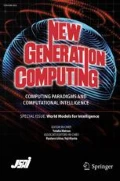Abstract
We address the problem of collecting information about failures and successes while unifying a set of equations. This is relevant to the study of efficient backtracking, for which Cox used the concept of maximal unifiable subsets while Bruynooghe and Pereira used a notion which is closely related to that of minimal non-unifiable subsets. As we show, both these concepts play a fundamental role in the process of exploring the search space for breadth first resolution in logic programs. In a special case they lead to similar search strategies but in general have complementary and even incompatible aspects. We then show that an algorithm due to Yasuura is particularly well suited as a basis for a method to construct the maximal unifiable subsets and minimal non-unifiable subsetsin conjunction with the unification process. In addition to its simplicity this method provides an answer for two problems raised by Cox concerning the preservation of successful partial computations and unification without occur check.
Similar content being viewed by others
References
Bruynooghe, M. and Pereira L. M., “Deduction Revision by Intelligent Backtracking,” inProlog Implementation (J. A. Campbell, ed.), pp. 194–215, 1984.
Chang, C. C. and Lee, D. C. T.,Symbolic Logic and Mechanical Theorem Proving, Academic Press, 1973.
Cox, P. T., “Finding Backtrack Points for Intelligent Backtracking,” inProlog Implementation (J. A. Campbell, ed.), pp. 216–233, 1984.
Jaffar, J., Lassez, J-L and Lloyd, J. W., “Completeness of the Negation as Failure Rule,”Proceedings of the International Joint Conference on Artificial Intelligence, pp. 500–506, 1983.
Kowalski, R. A.,Logic for Problem-Solving, North-Holland, 1981.
Lassez, J-L and Maher, M.J., “Closures and Fairness in the Semantics of Programming Logic,”Theoretical Computer Science, Vol. 29, pp. 167–184, 1984.
Matwin, S., and Pietrzykowski, T., “Exponential Improvement of Exhaustive Backtracking: Data Structure and Implementation,”Proc. 6th Conference on Automated Deduction, pp. 240–259, 1982.
Pietrzykowski, T., and Matwin, S., “Exponential Improvement of Efficient Backtracking: A Strategy for Plan Based Deduction,”Proc. 6th Conference on Automated Deduction, pp. 223–239, 1982.
Port, G. S., “Control Strategies for Logic Programs,”Ph. D. Dissertation, Department of Computer Science, University of Melbourne, forthcoming.
Yasuura, H., “On Parallel Computational Complexity of Unification,”Proceedings of the International Conference of Fifth Generation Computer Systems 1984, pp. 235–243, 1984.
Author information
Authors and Affiliations
About this article
Cite this article
Chen, T.Y., Lassez, J.L. & Port, G.S. Maximal unifiable subsets and minimal nonunifiable subsets. New Gener Comput 4, 133–152 (1986). https://doi.org/10.1007/BF03037439
Received:
Revised:
Issue Date:
DOI: https://doi.org/10.1007/BF03037439



